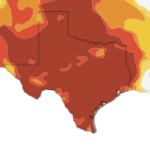To Break the Drought, Hoping for a Perfect Storm
It’s a typical summer in Texas: hot and dry with occasional bursts of scattered showers. But as the state continues to recover from a historic drought, more than typical weather is needed.

yum9me / Flickr/Creative Commons
An action figure of X-Men's Storm. Her ability to conjure up powerful storms would be highly coveted in drought-stricken Texas.
One way the state can receive precipitation during the summer’s dog days is a tropical storm. Of course, such an event can do as much harm as good. And absent the talents of the X-Men’s Storm, there’s no way to conjure up such an event.
Bob Rose, meteorologist at the Lower Colorado River Authority (LCRA), explains what a heat-beating storm would look like: “If we could somehow get a weak tropical storm, or a tropical depression, to come inland maybe along the lower or middle Texas coast, and work its way into Central Texas,” he says, that would be “our perfect mix for bringing significant rain and cooler temperatures.”
Victor Murphy of the National Weather Service agrees with the nourishing potential of a tropical storm. He says that “a tropical cyclone or at the very least a tropical disturbance” would be “the only shot for significant widespread improvement until the fall.” The downside, Murphy explains, is that there is often no way to confirm that a storm is headed toward Texas until, at most, a week out from its landing.
Absent the perfect storm, does Texas have any hopes of breaking the drought anytime soon?
Bob Rose provides the discouraging news. Even though the last portions of the state recently left “exceptional drought,” the worst stage possible, he explains that much of the state is regressing into more extreme stages. “If we don’t see any significant rain in July, I wouldn’t be surprised to see this extreme drought expand across much of the rest of Central Texas.” (See the most recent numbers in this week’s US Drought Monitor Map.)
Victor Murphy says the past couple of months have been abnormally dry for much of the state, despite a wet start to the year. “For the period from May 16 to July 5, a period of almost seven weeks, the Austin area has seen only 0.44 inches [of rain],” he said in an e-mail. In an average year, Austin would get six inches of rain during the same period, making the past seven weeks “the driest such period on record in Austin in over 100 years (since 1911).”
But despite these dour conditions in the short-term, there are promising projections for relief in the long run. Murphy says that “with each passing day, it’s looking more and more certain” that an El Niño weather pattern will arrive in the fall to lead us out of the meteorological black, since El Niños typically bring above-average precipitation.
If anything, Texans can take solace in the fact that this summer is not projected to be as stifling as last year. Bob Rose estimates that, even though Austin had 90 days in the triple digits last year, “this summer we’re probably gonna end up with a total of something around twenty to twenty-five” days over a hundred degrees. Less scorching weather is a nice prospect, but the even greater hope is for the perfect storm.

